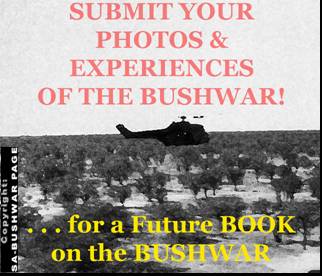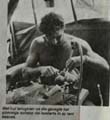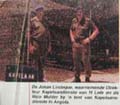| SOUTH-AFRICAN BUSHWAR WEBSITE OPERATIONS MODULAR - HOOPER - PACKER - DISPLACE - 1987 - 1988. SADF/UNITA against the FAPLA/CUBAN/SOVIET Forces |
 |
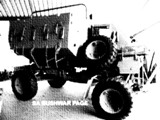 |
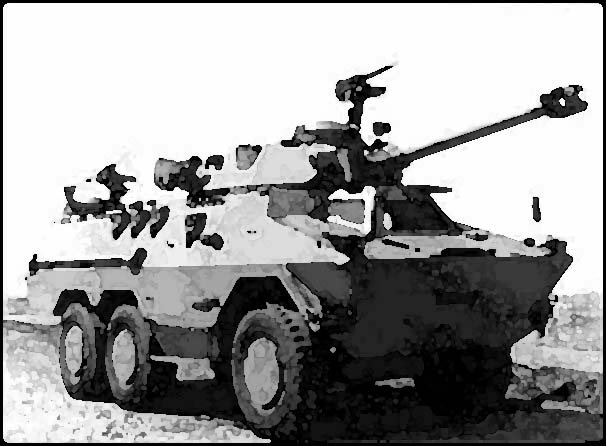 |
| For a short history of the campaign, go HERE |
| The SADF responded to UNITA requests for assistance during the FAPLA offfences of 1985, 1986 and 1987. Each year the assisatnce grew, and with the 1987 campaign culminated in a 3000-men strong SADF task force stopping the FAPLA/CUBAN advance on Mavinga and Jamba. Was it not for the SADF, UNITA would most likely have been crushed by the 1987 campaign. The SADF assistance remained limited and UNITA bore the brunt of the infantery requirements of the battles, and sufferred the vast majority of losses in men and material on the SADF/UNITA side. Recognised by miliraty experts of the time, the SADF was a formedable fighting force, well expereinced in bush warfare, and it most cases defeated larger and better equiped forces on the battlefield. The FAPLA/CUBAN forces fought bravely under very difficult circumstances (poorly trained and led, low morale; but being equiped with the best eastern Bloc weapons. The last battles of the Bushwar are politically tainted and the web is full of claims of victory from both sides. This page endevours to remove the political spin and reveal the truth from an a-political military history perspective. |

|
| To easily copy your old photos either scan them, or re-photograph them with a digital camera. Remeber to use the "macro' function for close-up photography and switcth the flash off to prevent glare on the photos. Good indirect sunlight is perfect. |
| Tp reserve the history of the Bushwar, please send your photos and memories to this email address, and it might be dispayed on this website or in the planned book about the Bushwar! |
| THE SADF & UNITA FORCES |
| Video still from a SADF 81mm mortar team in action. This and the next photos were most likely taken during the campaign, as the vegetation is typical of the area of the Ops Modular/Hooper/Packer battles. The 81mm mortars formed part of the fire support teams of the SADF forces and was regarded as an infantry weapon, as opposed to the larger 120mm M5 mortars used by the Artillery and airborne forces. The soldier on the left is the loader, dropping the bombs into the tube, and the one on the right is aiming the weapon. |
 |
| Another video still of a 81mm mortar commander on the radio, near a stack of bombs ready to be fired. In the background, one can see the typical Angolan terrain in early summer, with trees budding new leaves, while the grass is still the previous seaons' growth. |
| A mechanised version of the 81mm mortar mounted in the troop compartment of a modified Ratel ICV - called a Ratel 81. The weapons crew is seen here operating the mortar. The vegetation in the background indicates that the caption was taken in winter, and therefor was most likely not taken during this campaign. The Ratel 81 was used extensively by 61 Mech. Bde during the campaign. The crew are wearing helmets with radio communication equipment fitted. |
| View from the top of a Ratel 20mm ICV, "bundubashing" its way through the African Bush. The SADF vehicles were built with the capability for off-road movement. The Ratel 20 till today, forms the mainstay of the SADF/SANDF mechanised forces. It has room for 10 fully equiped soldiers, and is made in versions such as 90mm AT, 20mm ICV, 60mm Mortar, 81mm Mortar, and Command 12,7mm. |
| A SADF shell from a Ratel hitting an enemy bunker. True to Soviet doctrine, the FAPLA forces were always well dug in, with substantial trenches and underground bunkers. On the otherhand, the SADF doctrine focussed on mobility and flexibility. SADF field positions therefor had less excavations and trenches. |
| A SADF column moving to the front, passing burning veld. On the left are two Ratel IVC's and on the right is a open top Buffel mine resistant APC. Troops can be seen riding on the roofs of the Ratels. The dense vegetation is evident and contacts often occurred over very short distances. FAPLA tanks and Ratels often fired at each other over less than 150m. |
| Picture taken during the campaign, giving a good indication of the difficulties expereinced by large conventional forces: Lack of visibility, dense vegetation, deep loose sand. The overgrowth on many occations, saved the SADF from the superiorly equiped FAPLA airforce attacks. Camouflage and concealment was an important part of SADF tactics. The picture was taken from the top of a Ratel and a 2nd Ratel 20mm ICV is barley visible further back. |
| Heart break Hill?? The deep loose sand reduced mobility drastically, and heavily laden trucks and armour had difficulty negotiating the hills on the Chambinga Highground, where this picture was most likely taken.Visible in the picture is an Armoured Recovery Vehicle (ARV) based on an Olifant chassis, and an Olifant Tank. The churned sand in the foreground, illustrates the diffculty experienced by wheeled vehicles getting over the dune. Not ideal country for mechanised forces. |
| SADF armour on the move during the campaign. On the left is an Olifant Tank, and a Ratel ICV on the right. Note the infantry riding on the vehicles, including black soldiers belonging either to SWATF, 32Bn or Unita. |
| .5 Olifant tanks of Ecco Sqn on the move in a southerly direction to the Vimpulo river area as part of 4 SAI's effort to cut off 21st FAPLA Brigade from its escape around the Vimpulo source. 21st Bde managed to escape but suffered some losses on the way by constant SADF long range artillery bombardments. |
| SADF Special Forces inspect a FAPLA PT-76 amphibiuos tank, stuck in a river during one of the many failed attempts to cross a river in the battle area. |
| a SADF Ratel column from 32Bn anti-tank Sqn moves over the Kavango pontoon bridge, back to join the rest of the unit west of Mavinga, after being released from operations on 21 August 1987. 32Bn had camauflage uniforms while the SADF wore its "browns". |
| SADF troops pose in a 250kg bomb crater left by a FAPLA plane. The loose sand made for spectacular bomb craters, but to a large extent, neutralised the effectiveness of the blast and schrapnel. The FAPLA airforce attacks seldom came near the SADF troops. The SADF went for cover most of the time when a "Victor-Victor" (vyandelike vliegtuig) warning came over the radio. The SADF intercepted FAPLA communications, and knew when planes took of from Menongue. This bomb was intended for the SAAF air defence unit. |
| A SADF Casspir from Liaison team 2 with Capt John Mortimer on top. He was standing in for Les Rudman during his brief break in July 1987. The liaison teams were the first SADF troops to join UNITA after it called for assistance. These teams assessed the situation and fed the SADF with info at the onset of the campaign. The liaison teams also provided C+C assistance to UNITA. |
| SADF Intelligence Officers comb through an abandoned FAPLA brigade base soon after its hastely departure. Valueble intelligence was gathered from documents and maps sometimes left behind, ammunition types and quantities, base size and layout, footprints and vehicle tracks, etc. FAPLA troops often abandoned bases and equipment, which helped the intelligence gathering effort. The typical underground bunkers and rudimentary furniture is visible in the photo. |
| A SADF Kwevoel 10ton truck under cover during the campaign. The Kwevoel range of vehicles were mine and bullet proof; and the SADF only used softskin vehicles in the rear for logistical purposes - an expensive lesson being learned by US and UK forces in Iraq and Afghanistan now 30 years later! |
| 24 October 1987, Major Andre Retief briefs SADF tankers for the first SADF tank action since WWII - the attack on 16 Bde on 9 November 1987. In keeping witha SADF tradition, the troops are growing beards when deployed in the field for long periods, and to be recognised as "ou manne" (veterans), as opposed to "rowers' (fresh intakes) with short hair and no facial hair. Vehicles are camauflaged under netting in the background. |
| A Ratel ICV in the typical terrian of the combat zone. The dense bush is evident again, simultaniously benefitting and hampering the fighting forces. |
| Storie...A Ratel ICV passes an Olifant Tank on a dirt track during the campaign. The area was virtually without roads or development, and most of the fighting took place in the bush. The vehicles are camauflaged with fresh branches. |
| SADF 155mm G5 howitzers fire during the campaign. During the campaign, it was regarded as the best artillery piece in the world in its class, firing to a range of 40kms with great accuracy, while contemporaries could only manage a range of about 29kms.. The sixteen G5 and three prototype G6's won the campaign for the SADF, and largely neutralised the FAPLA aerial superiority. The dense vegetation meant that the guns could hide from the enemy, and despite continious efforts, FAPLA never located damaged the guns. Each gun could cover an area of 5000km2, |
| SADF forces preparing to blow up an abandoned FAPLA PT76 amphibious tank. The many rivers in the battle area were severe obsticles and to a large extent, dictated the course of the battles. The SADF troops are wearing a variety of captured webbing, this was often done as part of collecting souvinneers from the enemy. (Not sure if it was taken during the actual campaign, will confirm.) |
| Ops Modular: SADF troops showering in the veld under a field shower mounted on the back of a Kwevoel 100 truck. The location is Eco Sqn's laager at Mavinga. |
| SADF ORBAT during the initial phases of the campaign. Contrary to some false propogande claims, the SADF contingent never numbered more than 3000. From the above diagram one can calculate the full strength (which it never was) as follows: Combat Group Alpha: 260 Combat Group Bravo: 318 Combat Group Charlie: 122 20 Artillery Regt: 264 TOTAL: 964 combat soldiers, excluding HQ and Admin and Log. The mainstay of the Infantry forces was supplied by UNITA, and very little is known about the numbers, capabilities and casualty rates of UNITA during the campaign. At any given time several UNITA Battalions were engaged in the fighting, and attacking the rear and long supply routes of the FAPLA/CUBAN/SOVIET forces. |
| During phase 2 of the campaign, towards the end of OPs Modular, the SADF forces were restructured into purpose fit Combat Groups as indicated, but the strength remained the same as for phase 1; approximately 964 combat soldiers excluding HQ, Admin and Log, and the UNITA infantry. |
| During phase 3 of the campaign, for Operations Hooper and Packer, the SADF forces were increased to an estimated 1600 combat troops made up as follows: Combat Group Alpha: 182 Combat Group Bravo: 466 Combat Group Charlie: 760 20 Artilllery Regt: 192 TOTAL: 1600 This figure excluded HQ, Admin and Log, and in total, the SADF never deployed more than 3000 men during the campaign. |
| An SADF armoured formation on training at the Army Battle School at Lohatla in 1988. On this vast training ground, conventional exercised were held, in prEperation for the real campaigns. Should the war have continued beyond 1988, this unit would most likely have deployed to the Operational Area. |
| An SADF tank column of Foxtrot Sqn moving to the front in late December 1987, passing through Mavinga. Tank 51 Bravo is nearest to the camera. SADF tanks first saw service during the campaign on 9 Novemver 1987. |
| An SADF tank column moving to the front It can be seen from the tanks that they have been doing some bundu bashing, as all the rubber mudflaps over the front of the tracks are gone. The tanks are not yet kitted out for combat as in the next photo, where they are carrying spares such as bogie wheels and track sections. (Not confirmed that this was taken during the actual campaign) |
| Olifant Tank 51Bravo again! during the campaign, followed by 51 Alpha. Note the tank-unfriendly terrain. tank battles were sometimes fought over distances as small as 20 meters! |
| Members from Echo Sqn near Mavinga, 6 November 1987, Ops Modular. The beards indicate the troops have been in the operational area for a while. Two of then are wearing FAPLA hats captured from the enemy. |
| With their tank in the background, and rifles on the stretchers, the picture shows the accomodation of a tank crew in the field near Cuito Cuanavale, 1988. The shelter is dug in to protect them from shrapnel in the event of an attack. Each soldier in the SADF carried a shelter sheet, and in this care 2 sheets have been clipped together to form the shelter. Bedding in the field normally consisted of only a sleeping bag, but it appears in this photo as is two foldable stretchers were used. Stretchers were normally reserved for senior officers. |
| WOII Jacques de Wet and S/Sgnt Spikkels Terblanche on a Olifant tank neat Cuito Cuanavale, 1988. |
| The menace that eventually contributed in stopping the SADF advance - anti tank minefields. In keeping with Soviet defensive strategy, FAPLA created two and sometimes three layers of deep antitank minefields interdespersed with anti personnel mines; once the FAPLA forces have retreated to the bridgehead on the eastern Bank of the Cuito river. Here, the front bogie wheel has been blown of by a mine, and the crew is contemplating how to fix it. The blown-off wheel and stub-axle can be seen in the picture. |
| An Olifant tank with anti-mine rollers, same as was used during the campaign. Only a small number of rollers were deployed as not many were available. The leading tank in an attacking column would be equiped with rollers to clear a path through the minefield for other tanks and vehicles to follow. This tank is on display at the Armour museum in Bloemforntein. Picture taken in 2006. |
| Close-up of the mine roller in the previous picture. |
| Same as previous picture. |
| Tank killer! A Ratel ZT3 design as an anti-tank version of the very successful South African designed platform. This machine actualy took part in the campaign and was restored and are now on display at the Armour museum in Bloemfontein. During this campaign the SADF for the first time started using the 3-tone camauflage scheme for 32Bn vehicles as opposed the standard brown colour of SADF vehicles in other units. This Ratel has 3 kill markings on the side for shooting out 3 FAPLA T55 tanks. |
| Close-up of the kill markings on the ZT3 Ratel in the previous picture. The ZT3 were used in the open areas and over longer distances that the Ratel 90mm which often engaged enemy tanks and vehicles over very short distances in the bushy terrain. |
| An artist painting of an air-toair engagement during the campaign. Depicted are an Angolan MIG 21's often flown by Cuban pilots and SAAF Mirage F1 interceptors. |
| A SAAF Mirage F1 interceptor at the ready in its proteced shelter in a N. Namidian base. It has the late war grey camauflage scheme, as opposed to the earlier 2-tone scheme. The revetment has a camauflage roof against Soviet spy satelites, and it served as shade and protection against indirect fire, such as from mortars, that were often used for stand-off bombardments of SADF bases in the operational area. At the back of the plane, the curved blast protection plate can be seen. The Mirage is armed with 2 SA made Helmet-Mounted-Sight Kukri V3B AA missiles - (modified Sidewinders). SAAF planes had to fly 400kms to the battle area, giving them only 10 minutes on target, while not enjoying air superiority. |
| The SADF's answer to the FAPLA/CUBAN air threat during the campaign - the Cactus low level SAM system. Being the first mobile radar guided SAM system in the world, specially manufactured by the French for the SAAF, the system was outdated during the Cuito Cuanavale battles and although fired in anger on a few occations, did not affect any losses on the enemy. The vehicles were not suited for the African bush, and the system was withdrawn after a limited operational delpoyment of XXXX. It had the advantage of keeping the Angolan MIGS at a higher altitude, adding to their already inefficient ground attacks. |
| Same as the previous picture; the SAAF Cactus SAM missile vehicle next to its rival, the Soviet SA-9 Gashkin SAM system. With Soviet and Cuban support, the SAAF/SADF faced one of the most sofisticated AA defence systems outside the then Soviet Bloc. Operated by the SAAF, xxx Cactus systems were deployed during the campaign. The French operated and sold the system as the Crotale. |
| The Cactus system consisted of 2 vehicles; a missile and guidance radar vehicle, and a seperate search radar vehicle - depicted above. Heavily camouflaged on the Chambinga Highgrounds, the AA system operated by the SAAF, once came under inaccurate BM-21 fire. These pictures were taken at the SAAF museum at Zwartkops AFB in 2007. |
| On 14/12/89, about one year after the end of the campaign, this Angolan MIG21 got lost on a ferry flight and ran out of fuel in N. Namibia. It is included here to illustrate the type, together with the more advanced MIG23's which were the main foes to the SAAF. It is currently on display at the SAAF museum at Zwartkops AFB, Pretoria. |
| Mavinga airfield during the campaign. It was the SADF's main airstrip nearest to the battlefield. Mavinga was also the UNITA stronghold, the main target of the FAPLA offensive. A dirt airstrip just long enough for C160 and C130 transports, all vital equipment were flown to Mavinga. This include spares, rations, 155mm ammunition, etc. The writer;s brother was a technician on some of these flights and recalled the night-flights with C130's flying in 155mm ammunition by the plane loads just to keep the guns firing. The SADF was heavily dependant on the superior range of the G5 and G6 guns to maintain the initiative on the battlefield. It is not the most economic option to fly heavy artillery ammunition in by plane, but the SADF had no other option as the overland logistical route of 400km through bush, could not keep up with the demand. When a plane was appoaching Mavinga airfield at night, UNITA soldiers would lit tins with parrafin along the runway as landing lights. There were also no landing instrumentation at the airport, and planes relyed on own navigation to find Mavinga. The SADF only flew logistical missions at night, due to the FAPLA air superiority during the day. Upon landing, the load would rapidly be ofloaded, sometimes while the plane is slowly taxiing, and the parrafin landing lights would be extinguished as soon as a plane has taken off. The landings were always tactical, with a very sharp decent and accent to avoid SAM missiles and gun fire. (This photo in another book says it was taken at Rundu AFB) |
| A SAAF Bucaneer takes off with a prototype stand-off weapon to destoy the Cuito Cuanavale bridge. A previous attempt with the prototype weapon failed on 12 December 1987, but the 2nd was successful on 3 January 1988, destroying the mid-section of the bridge. No heavy traffic could make use of the bridge after this attack, rudementary repairs were made for pedestrian traffic, while vehicles crossed on pontoon bridges. These were bombed frequently with SADF G5's. |
| A Raptor 1 TV-guided stand-off weapon on display at AAD 1998; the prototype predecessor of this weapon was used to bring down the Cuito Bridge as explained in the previous picture. It was the SAAF's first "smart weapon" |
| A Seeker I RPV, similar to the type to make its operational debut during the campaign with 10 Sqn. Developed with Isreali assistance, the SADF used the Sekker to pin-point the FAPLA brigades in the bush. Not idealy suited for area reconnaisance, it was designed for a artillery target aquisition.The RPV unit saw only limited service from for only one month as the weapon was still in the development phase. 20 operational missions were flownIt proofed very useful, but three fell pray to the strong FAPLA air defences. It proofed vulnarable to SAM's and AA fire, despite expensive missiles being expened to bring some of them down. In one instance 17! missiles were fired at a RPV before it was downed. |
| 3 Squadron lining up at its Namibian base in 1988 to withdraw to the RSA after the campaign. The first 3-man formation consisted of the Comandant, Major Dup and Anton; and the second formation consisted of Johan, Frans and Maj de Beer. |
| SADF troops after Operation Modular. It is clear from the breads and long hair that the troops were in the veld for an extended time. On the left, next to the banner is Genl. Jannie Geldenhuis the then Chief of the Army. The banner reads: "Still Champions". |
| SADF troops listening to a speech by Genl. Jannie Geldenhuis after the Modular campaign. Due to the hot African summer some are wearing army T-shirts, and each appears to hold a certificate issued for participation in the campaign. Note again the long hair and beards. |
| SADF columns preparing its orderly withdrawal after the Modular campaign. The vehicles are still displaying the white operational numbering for vehicle identification and call signs. In the foreground are Ratel IFV's and Buffel MRV's are visible further back. |
| SADF troops demobilising after Operation Modular. Personal kit are being inspected and loaded on SAMIL 100 10-ton trucks returning to Namibia. Personal kit wewr carried in 1.2m long round duffel bags seen here, called "balsakke" in Afrikaans. |
| The SADF was a strict Protestant and very religious organisation, with prayers daily before meals, and on the parade ground. Other religions were allowed but as numbers were much smaller, these practised its religious activities seperately. Chaplans accompanied the troops on operations as this Chaplan's tent and chaplan (devil dodger!) with purple beret during Operation Modular depicts. |
| SADF operational drivers posing in front of their vehicles during Ops Modular. Note the captured FAPLA caps and "Grensvegter'/"Rambo" pose! Often t-shirts were worn after being in the veld for a while and dicipline is wearing off. The long hair and beards are a further sign of being "ou manne" (veterans). The drivers had to negotiate 400kms of mostly off-road conditions through the bush and loose sandy soil to and from the battlefield and the SADF bases in Namibia. |
| Lt's Gawie Combring and Martin Bremer with a brass bell taken from a FAPLA brigade during Ops Modular. On the bell is enscribed: "ANO SANTE DE 1950, it was broken out of a Portuguese colonial church by FAPLA. Many FAPLA brigades had such bells - it is speculated that it could have been used for signalling purposes.. |
| Cpl Duncan taylor with all his kit, ready to "klaar-out" (demob) after Operation Modular in December 1987. The 2 year natioanl Service cycle caused continuety problems for the SADF, as troops had to be rotated at the end of each year as the "ou manne' "klaared out", and the new intake of "rowers" (new recruits) commenced with National Service. After Ops Modular, Ops Hooper commenced with some PF members, but largely a new intake of National Service men. |
| A baby Blue Velvet monkey adopted as a pet during Ops Modular. Note the standard issue SADF cup with the SA National Crest . These cups were virtually unbreakable and survived army life well. |
| Support troops sorting magazines, newspapers and games for issue to the troops during Ops Modular. The logistical support, both operational and leasure as shown here, were stretched as the battlefield was 400kms from the SADF bases in Namibia. |
| A SAMIL 100 10-ton truck specially kitted out as a mobile refreshment shop. ARMY shops were operated by SAWI - Suid Afrikaanse Weermag Industrie. These sold items such as cooldrinks, sigarettes, shoe polish, sweets, stationary, etc at a price reduced from normal commercial shops. The writer even bought a fridge at SAWI in Voortrekkerhoogte which is still going strong after 20 years! |
| A makeshift volleyball course in a bush base during Ops Modular. Easy to erect a volleyball cource and organise a game, volley ball was a favourate passtime. |
| After Ops Modular, some troops needed dental care, and a visit to the dentist tent is shown in this picture. Note the dentists "uniform", ideal for the hot African sun. |
| The role of UNITA is often under-estimated in the Angolan campaigns. The civil war in Angola was between MPLA and UNITA, and the role of the SADF was only in support of UNITA. UNITA bore the brunt of the fighting, and many UNITA soldiers died during Operations Modular, Hooper, and Packer. The exact number of casualties are unknown, and as far as the writer knows, has never been researched or published. A personal estimate is 1500 dead and 1000 wounded. |
| Capt Walther, so named for the Walther P38 pistol he always carried, and Major "Zero", typical UNITA leaderhip during the Ops Modular - Hooper - Packer campaign, that spent time with the SADF in joint operations. |
| Unita soldiers on a BTR60 captured from FAPLA, Most of UNITA's hardware was captured from the enemy, as the SADF support was limited to logistical, and command and control support. However, the SADF often handed over captured hardware to UNITA. Note the circular opening at the back for amphibious operations. |
| The Cunene river; border between the former SWA (Namibia) and Angola, prior to crossing into Angola as part of Ops Modular - late Sept. 1987. (Photo by "Bundu Basher" on www) |
| Troop 1, Charlie Squadron, September 1987 - en route to Angola from South Africa via South West Africa - a trip of some 5 days, travelling at night only and sleeping by day.
Bundu Basher is in the front, second from the left. (Photo by "Bundu Basher" on www) |
| Bundu Basher and friends in 1986. Tragically, the person on the right, Lt Adrian Hind, was a casualty of Operation Moduler when an Angolan tank took out his Ratel 90, while serving with 61 Mechanised Battalion.(Photo by "Bundu Basher" on www) |
| Ratel 90's from Troop 1, Charlie Squadron, 4SAI, moving through the Angolan terrain, during Operation Moduler, November 1987. (Photo by "Bundu Basher" on www) |
| A view from a Ratel 90 of the battle field of the attack on the 16th, 47th and elements of the 59th Brigade of FAPLA by 4SAI. The shot out tanks that littered the battlefield can clearly be seen in the picture - October 1987(Photo by "Bundu Basher" on www) |
| A FAPLA (Angolan Army) fox hole, inside Angola - October 1987(Photo by "Bundu Basher" on www) |
| A picture of an abandoned FAPLA (Angolan Army)fox hole, inside Angola, October 1987.(Photo by "Bundu Basher" on www) |
| An Olifant Mark 1 MBT about to experience it's baptism of fire in Angola, October 1987, against the the Angolan 16th, 47th and elements of the 59th Brigade - as part of the 4SAI attack (Fighting Group Charlie)(Photo by "Bundu Basher" on www) |
| A 4SAI Ratel 90 from Troop 1, Charlie Squadron, under a camoflauge net during a break in the attacks, inside Angola, November 1987. The Angolan Air Force had air superiority during the day and all static vehicles were camoflauged when not engaged in tactical movements.(Photo by "Bundu Basher" on www) |
| MORE TO FOLLOW SOON!!! |
